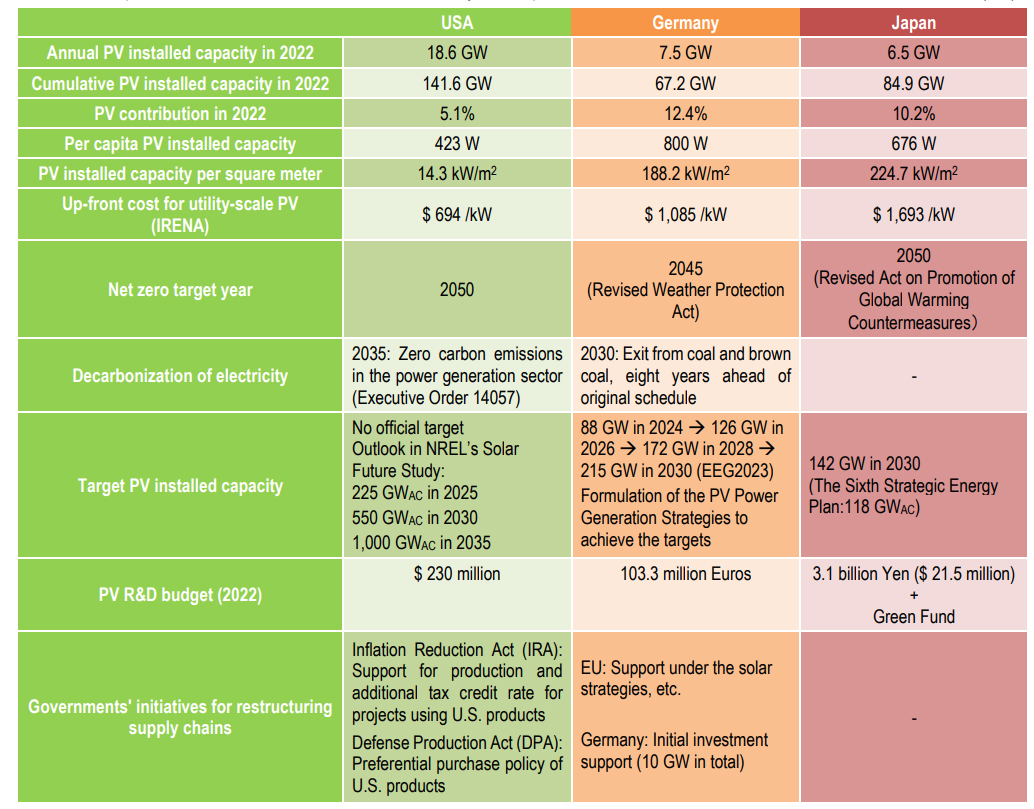As reported in the RTS Monthly Perspective section of May 2023 issue of this report, the G7 declaration stated that “The G7 will increase the cumulative PV installed capacity to 1 TW or more by 2030” at the G7 Hiroshima Summit. The three countries of the United States, Germany, and Japan will account for about 85% of the total (based on an estimate) and will be the leading countries in realizing the introduction of 1 TW or more. Comparing the current efforts of these three countries to expand the introduction of PV power generation, as shown in Table 1, Germany and the United States have clearly set decarbonization targets for the electricity sector. In the US, the national goal is to reduce carbon emissions in the power generation sector to zero by 2035 by an executive order. In Germany, the goal of “realizing coal and brown coal exits by 2030, eight years ahead of schedule”, decided under the administration of former Chancellor Angela Merkel has been inherited under the Scholz administration.
PV is expected to play a major role in the energy transition. As RTS mentioned in June 2023 issue of this report, Germany has set a strategic target of 215 GW of PV installed capacity by 2030, and in the United States, although no official introduction target has been set, the National Renewable Energy Laboratory (NREL) has given a vision of what PV power generation should be like to achieve “zero carbon emissions in the power generation sector.” The “Solar Future Study” by NREL estimates that the ratio of PV power generation in the United States will reach 40% by 2035, which may increase further to 45% by 2050, estimating the cumulative installed capacity will be 550 GWAC (= 660 GWDC) by 2030 and 1,000 GWAC (= 1,200 GWDC) by 2035.
The United States plans to introduce PV systems through the tax credit system (ITC) and Germany through the FIT and FIP programs, but at the same time, both countries are aiming not only to introduce PV systems but also to rebuild the PV manufacturing industry. In the United States, the Inflation Reduction Act (IRA) provides incentives for the production of PV products and adds bonuses to the investment tax credit rate for the adoption of U.S. products to encourage domestic production of solar cells. Furthermore, as solar cells have become the object covered by the Defense Production Act (DPA), PV modules and their components (including crystalline silicon ingots, wafers, glass for solar cells and solar cells) are now regarded as critical technology products for national defense and U.S. solar cells are eligible for preferential purchase and other support by the national government.
In Germany, a public call for manufacturing projects was launched in June 2023 with the aim of establishing a 10-GW/year domestic production capacity.
Meanwhile, in Japan, the GX Promotion Act and the GX Decarbonized Power Source Act were enacted in May 2023 based on the Basic Policy for the Realization of GX and the Basic Policy was replaced by the GX Promotion Strategy which has legal grounds. Following these initiatives, the acceleration of efforts to achieve both decarbonization and a stable energy supply will begin. Under the GX Promotion Strategy, the Sixth Strategic Energy Plan, which was formulated in 2021, is expected to be revised. To promote the shift to decarbonized power sources further, the transition to renewable energy electricity will be accelerated, with PV power generation as the main driver. For expanding the introduction of PV power generation, Japan must aim to formulate the drastic Seventh Strategic Energy Plan that keeps pace with Europe and the United States. The Seventh Strategic Energy Plan should include not only the measures to increase PV installed capacity simply, but also multifaceted development measures, such as securing a supply chain, industrial policies, mandatory PV installation on buildings, overcoming grid and location restrictions and improvement of social acceptance.
Currently in Japan, the deployment of renewable energy by the Ministry of the Environment (MoE) and local governments has begun, and mandatory installation of renewable energy in new houses is planned by the Tokyo Metropolitan Government (TMG) and Kawasaki City of Kanagawa Prefecture, yet these new trends need to be expanded further.
Furthermore, considering the expanding introduction of PV power generation after 2030, we must start preparing from now for the rollout of PV power generation in harmonious coexistence with farmland, as typified by solar sharing (PV installations while continuing agricultural activities), which is becoming increasingly popular worldwide, together with people engaged in agriculture.

Note: Overpanelling ratio of the USA and Japan is assumed to be AC:DC = 1:1.2
©RTS Corporation
